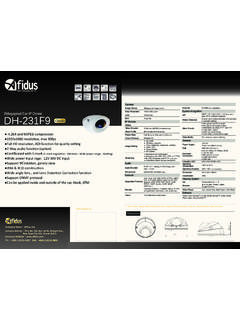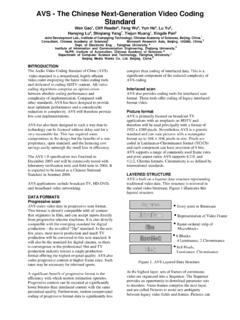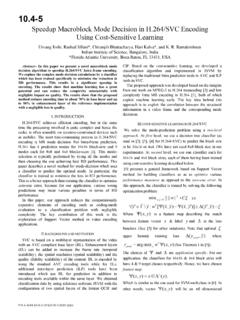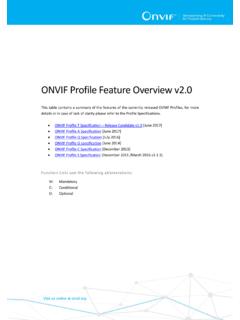Transcription of X264: A HIGH PERFORMANCE H.264/AVC ENCODER
1 In Preparation X264: A HIGH PERFORMANCE ENCODER . Loren Merritt and Rahul Vanam*. *Dept. of Electrical Engineering, University of Washington, Seattle, WA 98195-2500. Email: {lorenm, 1. INTRODUCTION. The joint effort by ITU-T's Video Coding Experts Group and ISO/IEC's Moving Pictures Experts Group resulted in standardization of AVC in 2003 [1]. Like previous standards, specifies only a decoder, therefore allowing for improvement in compression rate, quality and speed in designing the ENCODER . Since its standardization, there has been range of encoders developed by individuals and organizations. The ENCODER developed by the Joint Video Team, known as the Joint Model (JM) [3], has been used as a reference by ENCODER developers in enhancing existing algorithms.}
2 However, due to its speed, its use has been limited. Another open source ENCODER is the x264 [4]. Its development started in 2004, and it has been used in many popular applications like ffdshow, ffmpeg and MEncoder. In a recent study, x264 showed better quality than several commercial encoders [5]. In this paper, we compare the PERFORMANCE of the JM ENCODER (ver. ) with x264 (ver ) and show that x264 is about 50. times faster and provides bitrates within 5% of JM for the same PSNR. 2. X264. The high PERFORMANCE of x264 is attributed to its rate control, motion estimation, macroblock mode decision, quantization and frame type decision algorithms.
3 In addition, x264 uses assembly optimized code for many of the primitive operations. In x264, there are three quantization approaches: one of them is the uniform deadzone (called Trellis-0), and the other two use an algorithm based on trellis quantization [7], and is similar to, but developed independently from, the soft decision quantization of [8] (called Trellis-1 and Trellis-2). Rate Control 1. In Preparation Rate control allows selection of encoding parameters to maximize quality under the constraint imposed by specified bitrate and decoder video buffer. The rate control in can be performed at three different granularities group of pictures level, picture level and macroblocks level [a].
4 At each level, the rate control selects quantization parameter (QP) values, that determine the quantization of transform coefficients. Increase in QP increases quantization step size and decreases the bitrate. The rate control in x264 is based upon libavcodec's implementation [6], and is mostly empirical. There are five different rate control modes in x264 and are described below. In the hypothetical reference decoder (VBV) mode, x264 allows each macroblock to have a different QP, while in other modes QP is determined for an entire frame. Two pass (2pass). In this approach, data is obtained about each frame during a first pass, allowing x264 to allocate bits globally over the file.
5 After application of the first pass, the 2pass approach is implemented as follows: i. First the relative number of bits to be allocated between P-frames is selected independently of the total number of bits and it is calculated empirically by bits = complexity (1). where complexity is the predicted bit size of a given frame at some constant QP. I- and B- frames are not analyzed separately, but rather use the QP from nearby P-frames. ii. The results of (i) are scaled to fill the requested file-size. iii. Encoding is performed in this step. After encoding each frame, the future QPs are updated to account for mispredictions in size (this is referred to as long-term compensation).
6 If the second pass is consistently off from the predicted size, then offset = 2(real filesize/predicted filesize) / 6. (2). is added to all future QPs. Apart from long-term compensation, there is short-term compensation (using real filesize - predicted filesize instead of the ratio) to prevent x264 from deviating too far from the desired file size near the beginning (when there is less data for long-term compensation) and near the end (when long-term compensation does not have 2. In Preparation time to react). Short-term compensation is based on the absolute difference between encoded size and target size, rather than the ratio.
7 Average bitrate (ABR). This is a one-pass scheme where the rate control must be done without knowledge of future frames. Therefore, ABR can not exactly achieve the target file size. The steps given below are numbered to match the corresponding steps in 2pass. i. This is the same as in 2pass, except that instead of estimating complexity from a previous encode, we run a fast motion estimation algorithm over a half-resolution version of the frame, and use the Sum of Absolute Hadamard Transformed Differences (SATD) of the residuals as the complexity. Also, the complexity of the following GOP is unknown, so I-frame QPs are based on the past.
8 Ii. We do not know the complexities of future frames, so we can only scale based on the past. The scaling factor is chosen to be the one that would have resulted in the desired bitrate if it had been applied to all frames so far. iii. Long and short term compensation is the same as in 2pass. By tuning the strength of compensation, it is possible to obtain quality ranging from close to 2pass (but with file size error of 10%) to lower quality with reasonably strict file size. VBV-compliant constant bitrate (CBR). This is a one-pass mode designed for real-time streaming. i. It uses the same complexity estimation for computing bit size as ABR.
9 Ii. The scaling factor used for achieving the requested file-size is based on a local average (dependent on VBV buffer size) instead of all past frames. iii. The overflow compensation is the same algorithm as in ABR, but runs after each row of macroblocks instead of per-frame. Constant rate-factor This is a one-pass mode that is optimal if the user does not desire a specific bitrate, but specifies quality instead. It is the same as ABR, except that the scaling factor is a user defined constant and no overflow compensation is done. Constant quantizer 3. In Preparation This is a one-pass mode where QPs are simply based on whether the frame is I-, P- or B- frame.
10 Motion Estimation Motion estimation (ME) is the most complex and time-consuming part of the ENCODER . It uses multiple prediction modes, multiple reference frames. There are four different integer-pixel motion estimation methods provided by x264, namely: diamond, hexagon, uneven multihexagon (UMH) and successive elimination exhaustive search. UMH provides good speed without sacrificing significant amount of PSNR, while hexagon is a good tradeoff for higher speeds. The implementation of UMH in x264 is similar to JM's simplified UMH, except that it includes modified early termination. The following steps describe the early termination in x264: 1.







